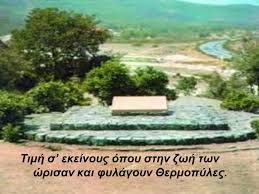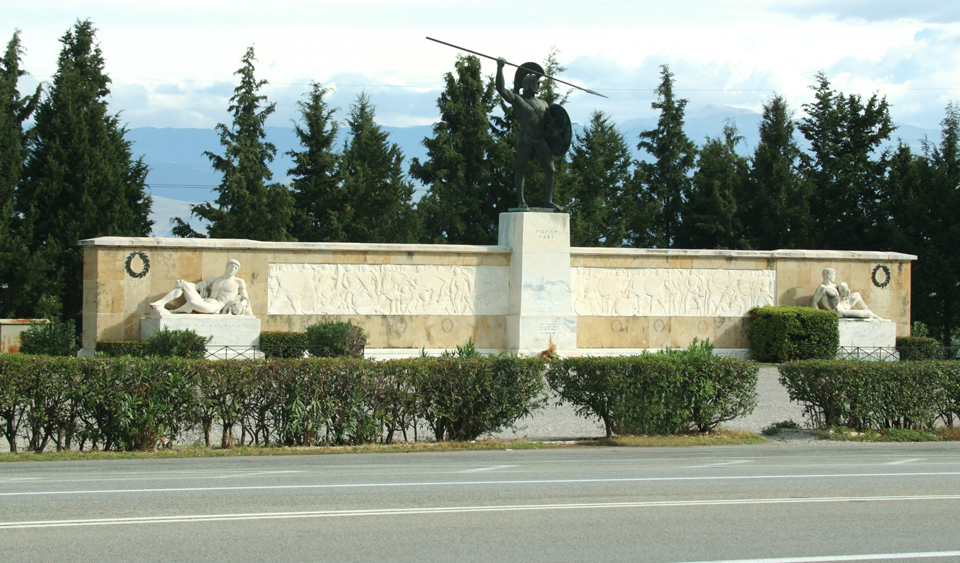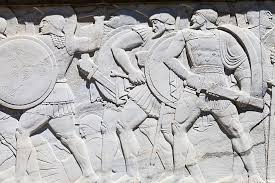Thermopylae

The Battle of Thermopylae ( Machē tōn Thermopylōn) was fought between an alliance of Greek city-states, led by King Leonidas of Sparta, and the Persian Empire of Xerxes I over the course of three days, during the second Persian invasion of Greece. It took place simultaneously with the naval battle at Artemisium, in August or September 480 BC, at the narrow coastal pass of Thermopylae ("The Hot Gates"). The Persian invasion was a delayed response to the defeat of the first Persian invasion of Greece, which had been ended by the Athenian victory at the Battle of Marathon in 490 BC. Xerxes had amassed a huge army and navy, and set out to conquer all of Greece. The Athenian general Themistocles had proposed that the allied Greeks block the advance of the Persian army at the pass of Thermopylae, and simultaneously block the Persian navy at the Straits of Artemisium. A Greek force of approximately 7,000 men marched north to block the pass in the middle of 480 BC. The Persian army, alleged by the ancient sources to have numbered over one million, but today considered to have been much smaller (various figures are given by scholars, ranging between about 100,000 and 150,000),[7][8] arrived at the pass in late August or early September. The vastly outnumbered Greeks held off the Persians for seven days (including three of battle) before the rear-guard was annihilated in one of history's most famous last stands. During two full days of battle, the small force led by Leonidas blocked the only road by which the massive Persian army could pass. After the second day, a local resident named Ephialtes betrayed the Greeks by revealing that a small path led behind the Greek lines. Leonidas, aware that his force was being outflanked, dismissed the bulk of the Greek army and remained to guard their retreat with 300 Spartans, 700 Thespians, 400 Thebans, and perhaps a few hundred others, most of whom were killed. At Artemisium, the Greek navy, under the command of the Athenian politician Themistocles, received news of the defeat. Since the Greek strategy required both Thermopylae and Artemisium to be held, and given their losses, it was decided to withdraw to Salamis. The Persians overran Boeotia and then captured the evacuated Athens. The Greek fleet—seeking a decisive victory over the Persian armada—attacked and defeated the invaders at the Battle of Salamis in late 480 BC. Fearful of being trapped in Europe, Xerxes withdrew with much of his army to Asia (losing most to starvation and disease), leaving Mardonius to attempt to complete the conquest of Greece. However, the following year saw a Greek army decisively defeat the Persians at the Battle of Plataea, thereby ending the Persian invasion. Both ancient and modern writers have used the Battle of Thermopylae as an example of the power of a patriotic army defending its native soil. The performance of the defenders is also used as an example of the advantages of training, equipment, and good use of terrain as force multipliers and has become a symbol of courage against overwhelming odds. First day On the fifth day after the Persian arrival at Thermopylae and the first day of the battle, Xerxes finally resolved to attack the Greeks. First, he ordered five thousand archers to fire a barrage of arrows, but they were ineffective; they fired from at least 100 yards away, according to modern day scholars, and the Greeks' bronze shields and helmets deflected the missiles. After that, Xerxes sent a force of ten thousand Medes and Cissians to take the defenders prisoner and bring them before him. The Persians soon launched a frontal assault, in waves of around 10,000 men, on the Greek position. The Greeks fought in front of the Phocian wall, at the narrowest part of the pass, which enabled them to use as few soldiers as possible Details of the tactics are scant; Diodorus says "the men stood shoulder to shoulder" and the Greeks were "superior in valor and in the great size of their shields. This probably describes the standard Greek phalanx, in which the men formed a wall of overlapping shields and layered spear points protruding out from the sides of the shields, which would have been highly effective as long as it spanned the width of the pass. The weaker shields and shorter spears and swords of the Persians prevented them from effectively engaging the Greek hoplites. Herodotus says that the units for each city were kept together; units were rotated in and out of the battle to prevent fatigue, which implies the Greeks had more men than necessary to block the pass. The Greeks killed so many Medes that Xerxes is said to have stood up three times from the seat from which he was watching the battle. According to Ctesias, the first wave was "cut to ribbons", with only two or three Spartans killed in return. According to Herodotus and Diodorus, the king, having taken the measure of the enemy, threw his best troops into a second assault the same day, the Immortals, an elite corps of 10,000 men. However, the Immortals fared no better than the Medes, failing to make any headway against the Greeks.[84] The Spartans apparently used a tactic of feigning retreat, and then turning and killing the enemy troops when they ran after them.[84] Second day[ On the second day, Xerxes again sent in the infantry to attack the pass, "supposing that their enemies, being so few, were now disabled by wounds and could no longer resist. However, the Persians had no more success on the second day than on the first. Xerxes at last stopped the assault and withdrew to his camp, "totally perplexed".Late that day, however, as the Persian king was pondering what to do next, he received a windfall; a Trachinian named Ephialtes informed him of the mountain path around Thermopylae and offered to guide the Persian army. Ephialtes was motivated by the desire for a reward. For this act, the name of Ephialtes received a lasting stigma, his name coming to mean "nightmare" in the Greek language and becoming the archetypal traitor in Greek culture. Herodotus reports that Xerxes sent his commander Hydarnes that evening, with the men under his command, the Immortals, to encircle the Greeks via the path. However, he does not say who those men were. The Immortals had been bloodied on the first day, so it is possible that Hydarnes may have been given overall command of an enhanced force including what was left of the Immortals, and indeed, according to Diodorus, Hydarnes had a force of 20,000 for the mission. The path led from east of the Persian camp along the ridge of Mt. Anopaea behind the cliffs that flanked the pass. It branched, with one path leading to Phocis and the other down to the Malian Gulf at Alpenus, first town of Locris. Third day At daybreak on the third day, the Phocians guarding the path above Thermopylae became aware of the outflanking Persian column by the rustling of oak leaves. Herodotus says that they jumped up and were greatly amazed. Hydarnes was perhaps just as amazed to see them hastily arming themselves as they were to see him and his forces. He feared that they were Spartans, but was informed by Ephialtes that they were not. The Phocians retreated to a nearby hill to make their stand (assuming that the Persians had come to attack them). However, not wishing to be delayed, the Persians merely shot a volley of arrows at them, before bypassing them to continue with their encirclement of the main Greek force. Learning from a runner that the Phocians had not held the path, Leonidas called a council of war at dawn. According to Diodorus, a Persian called Tyrrhastiadas, a Cymaean by birth, warned the Greeks.[94] Some of the Greeks argued for withdrawal, but Leonidas resolved to stay at the pass with the Spartans.[93] Many of the Greek contingents then either chose to withdraw (without orders), or were ordered to leave by Leonidas (Herodotus admits that there is some doubt about which actually happened). The contingent of 700 Thespians, led by their general Demophilus, refused to leave and committed themselves to the fight. Also present were the 400 Thebans, and probably the helots who had accompanied the Spartans. Leonidas' actions have been the subject of much discussion. It is commonly stated that the Spartans were obeying the laws of Sparta by not retreating, but it seems it was actually the failure to retreat from Thermopylae that gave rise to the notion that Spartans never retreated. It is also possible that, recalling the words of the Oracle, Leonidas was committed to sacrifice his life in order to save Sparta. However, since the prophecy was specific to him, this seems a poor reason to commit 1,500 other men to a fight to the death. The most likely theory is that Leonidas chose to form a rearguard so that the other Greek contingents could get away. If all the troops had retreated, the open ground beyond the pass would have allowed the Persian cavalry to run the Greeks down. If they had all remained at the pass, they would have been encircled and would eventually have all been killed. By covering the retreat and continuing to block the pass, Leonidas could save more than 3,000 men, who would be able to fight again. The Thebans have also been the subject of some discussion. Herodotus suggests that they were brought to the battle as hostages to ensure the good behavior of Thebes. However, as Plutarch long ago pointed out, if they were hostages, why not send them away with the rest of the Greeks? The likelihood is that these were the Theban 'loyalists', who unlike the majority of their fellow citizens, objected to Persian domination. They thus probably came to Thermopylae of their own free will and stayed to the end because they could not return to Thebes if the Persians conquered Boeotia. The Thespians, resolved as they were not to submit to Xerxes, faced the destruction of their city if the Persians took Boeotia. However, this alone does not explain the fact that they remained; the remainder of Thespiae was successfully evacuated before the Persians arrived there. It seems that the Thespians volunteered to remain as a simple act of self-sacrifice, all the more amazing since their contingent represented every single hoplite the city could muster. This seems to have been a particularly Thespian trait – on at least two other occasions in later history, a Thespian force would commit itself to a fight to the death. At dawn, Xerxes made libations, pausing to allow the Immortals sufficient time to descend the mountain, and then began his advanceA Persian force of ten thousand men, consisting of light infantry and cavalry, charged at the front of the Greek formation. The Greeks this time sallied forth from the wall to meet the Persians in the wider part of the pass in an attempt to slaughter as many Persians as they could. They fought with spears until every spear was shattered and then switched to xiphē (short swords). In this struggle, Herodotus states that two brothers of Xerxes fell: Abrocomes and Hyperanthes. Leonidas also died in the assault, shot down by Persian archers, and the two sides fought over his body, the Greeks taking possession.[100] As the Immortals approached, the Greeks withdrew and took a stand on a hill behind the wall.[101] The Thebans "moved away from their companions, and with hands upraised, advanced toward the barbarians..." (Rawlinson translation), but a few were slain before their surrender was accepted. The king later had the Theban prisoners branded with the royal mark. Of the remaining defenders, Herodotus says: "Here they defended themselves to the last, those who still had swords using them, and the others resisting with their hands and teeth. Tearing down part of the wall, Xerxes ordered the hill surrounded, and the Persians rained down arrows until every last Greek was dead. In 1939, archaeologist Spyridon Marinatos, excavating at Thermopylae, found large numbers of Persian bronze arrowheads on Kolonos Hill, changing the identification of the hill on which the Greeks died from a smaller one nearer the wall. The pass at Thermopylae was thus opened to the Persian army, according to Herodotus, at the cost to the Persians of up to 20,000 fatalities. The Greek rearguard, meanwhile, was annihilated, with a probable loss of 2,000 men, including those killed on the first two days of battle. Herodotus says at one point that 4,000 Greeks died, but assuming that the Phocians guarding the track were not killed during the battle (as Herodotus implies), this would be almost every Greek soldier present (by Herodotus' own estimates), and this number is probably too high.
Thermopylae Museum
Περίοδος λειτουργίας: Χειμερινό: καθημερινές (Δευτ.-Παρ.): 8:00-17:00 και σαβ/κα: 9:00-17:00, Θερινό: καθημερινές (Δευτ.-Παρ.): 8:00-19:00 και σαβ/κα: 10:00-18:00 Εποπτεύων φορέας: Δήμος Λαμιέων Γενικές πληροφορίες: Τηλέφωνο: 22310- 93054
Distance
22 km (Through Google map)
Estimeted time:
20 min




